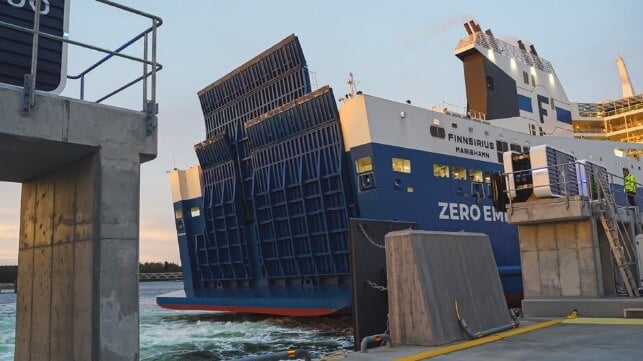Video: Swedish Port Uses Suction Mooring Improving Docking Speed and Safety

Starting in mid-September, Sweden’s Port of Kapellskär has begun using the country’s first automooring system, which uses a vacuum pad technology. According to port officials, the technology linked with an enhanced shore power capability makes mooring more efficient and improves the sustainability of the port’s operations, and in the future may be extended to other ports in the region.
The automooring system is first being used at Kapellskär located about 55 miles to the north of Stockholm and the region’s port for ro-ro operations. Well situated with easy access and strong land connections, the port has a total of five berths including ones used for ferry operations to Estonia, the Åland Islands, and Finland.
The system works with a series of vacuum pads replacing the need for conventional rope handling. It is activated by the ship and affixes to the hull. The only requirement is sufficient strength in the area to sustain the forces for docking and holding the ship on dock.
Port of Kapellskär offers Sweden’s first automooring using vacuum pads. This, together with the next-generation onshore power connections, makes mooring more efficient and improves the sustainability. Read more: https://t.co/5Cd9wSNz4X pic.twitter.com/lhUcvKcrfQ
— Stockholms Hamnar (@StockholmsHamn) October 2, 2023
According to port officials, automooring with vacuum technology eliminates the risk of injury. They highlight that the work handling conventional mooring lines carries the greatest injury risk during a vessel call. The pads can dock a vessel in less than 30 seconds and undock the vessel in just 15 seconds. Ships benefit from more efficient and faster handling which also reduces the use of engines in port reducing emissions.
The system was introduced to coincide with the arrival of Finnlines’ newest vessel, the Finnsirius. Introduced in September, the 65,692 gross ton vessel is the first of two state-of-the-art ships that will be making daily calls at Kapellskär as part of the service to Åland and Finland.
In addition to being technologically advanced, the new ship and a sister due to enter service in January 2024 are larger. The cargo capacity per vessel increases by 24 percent to 5,200 lane-metres and the passenger capacity doubles from the current 554 to 1,100 passengers as the new ships replace older ships. The vessels also for the first time will carry passengers arriving without cars while their larger size increases the need for efficient port handling.

Next generation on shore power is also provided at the Port of Kapellskär
“Together with Finnlines, we have planned and updated Port of Kapellskär with brand new technology before the brand new Finnlines vessel arrived," says Johan Wallén, Chief Commercial Officer at Ports of Stockholm. “Automooring using vacuum technology improves sustainability by providing a safer working environment and reduced environmental impact.”

that matters most
Get the latest maritime news delivered to your inbox daily.
Reducing the mooring time also means the vessels move quicker to shore power. Ports of Stockholm began to provide onshore power connections for vessels in the 1980s and all of its ports are now equipped with onshore power connection facilities. For the arrival of Finnsirius, the Port of Kapellskär also introduced a next-generation crane, a PowerReach NxG that improved the power transfer capabilities. The voltage capacity is 11,000 volts, or 11kV, which delivers power of up to 4 MVA, equivalent to the combined electricity consumption of 1,000 households.
The facilities for onshore power connection and automated mooring at the Port of Kapellskär were partly financed by the EU. The onshore power connection project also received funding from the Swedish national Climate Leap investment project.
